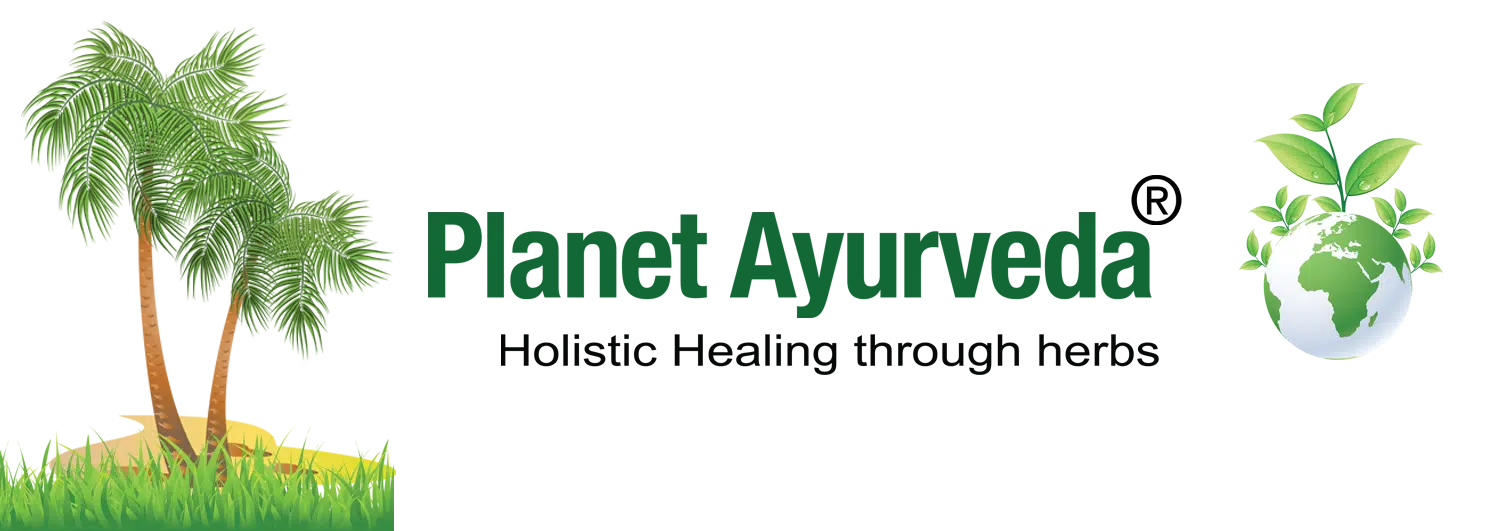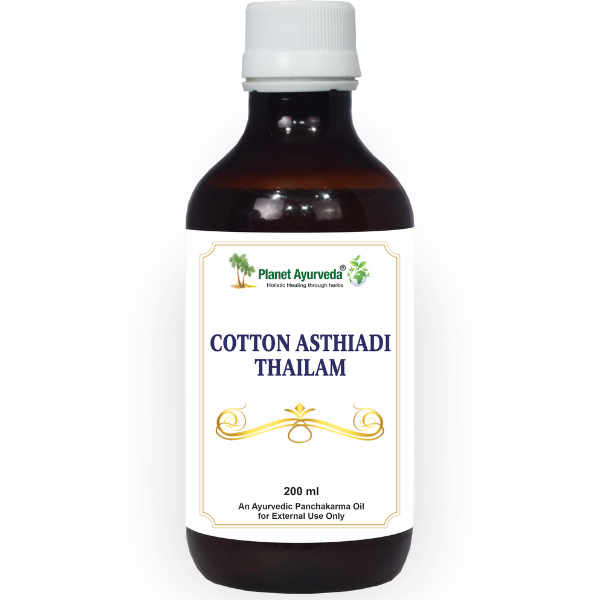Cotton Asthiadi Thailam – Key Ingredients, Their Benefits, Indications & Panchakarma Uses
Classical Reference : Karpasasthyadi Thailam
Introduction
Cotton Asthiadi Thailam by Planet Ayurveda is a classical Ayurvedic oil inspired by the formulation of Karpasasthyadi Thailam, renowned in Ayurvedic texts for its benefits in musculoskeletal and neurological conditions. It is prepared with cotton seed (Karpasa), sesame oil, and other therapeutic herbs. This medicated oil is highly effective in alleviating Vata-related disorders. It provides great relief in sciatica and low back pain, reduces stiffness of the hip and sacroiliac joints, and restores mobility. The nourishing properties of the oil make it particularly valuable in managing postnatal musculoskeletal weakness, strengthening muscles, bones, and ligaments. Regular massage with this oil improves circulation, relieves pain, and promotes flexibility, making it a trusted support for long-term joint and nerve health. Planet Ayurveda ensures authenticity and purity, delivering this oil in its most natural form for holistic recovery and rejuvenation.
Ingredients With Description
1. Karpasa (Gossypium herbaceum)
The seeds of Gossypium herbaceum contain gossypol, flavonoids, and fixed oils. These compounds have anti-inflammatory and analgesic actions that reduce nerve irritation and muscular pain. Gossypol particularly acts on neuromuscular tissues, helping with sciatic nerve pain and improving musculoskeletal tone. The oil content also provides nourishment in postnatal weakness, aiding tissue repair.
2. Bala (Sida cordifolia)
Bala is rich in ephedrine, vasicinone, flavonoids, and sterols. Ephedrine provides mild analgesic and nervine effects, while flavonoids reduce oxidative stress in muscles. Its rejuvenating and strengthening property makes it highly effective for postnatal musculoskeletal weakness. Alkaloids also calm nerve inflammation, useful in sciatica and stiffness of hip joints.
3. Masa (Teramnus labialis)
Masa contains proteins, essential amino acids, flavonoids, and sterols. These act as natural nutritive agents, restoring muscle bulk and strength. Flavonoids reduce local inflammation in muscles and joints, thus helping with low back pain and stiffness. The protein content is particularly beneficial in postnatal recovery, as it helps in rebuilding weakened muscles and ligaments.
4. Kulattha (Dolichos biflorus)
Horse gram seeds are enriched with flavonoids, phenolic acids, and proteins. Flavonoids act as anti-inflammatory agents, reducing swelling and stiffness in the sacroiliac joints. The phenolic content assists in reducing oxidative stress around inflamed nerve roots, easing sciatic pain. Being light and strengthening, it also helps in the gradual recovery of muscular strength after delivery.
5. Devdaru (Cedrus deodara)
The wood and resin contain sesquiterpenes, cedrol, and himachalol. These have proven anti-inflammatory and analgesic properties that relieve sciatica and back pain by reducing nerve irritation. Sesquiterpenes also act as muscle relaxants, thereby decreasing the stiffness of the hip and sacroiliac joints. Its strengthening nature supports musculoskeletal stability in postnatal weakness.
6. Rasna (Pluchea lanceolata)
Rasna contains alkaloids, sterols, flavonoids, and essential oils. These are well-documented for their anti-inflammatory and analgesic effects. They target vata disorders, especially sciatica and stiffness of joints. The sterols and flavonoids also support connective tissue repair, making Rasna helpful in managing low back pain and postnatal joint weakness.
7. Sarshapa (Brassica juncea)
Mustard seeds are rich in allyl isothiocyanate, glucosinolates, and fixed oils. Allyl isothiocyanate acts as a counter-irritant, increasing blood circulation locally, thus reducing stiffness and pain in the back and hips. Mustard oil provides warmth and nourishment, which is beneficial for sciatica pain relief and also supports tissue regeneration after childbirth.
8. Nagara (Zingiber officinale)
Ginger rhizomes contain gingerol, shogaol, and volatile oils. Gingerol and shogaol exhibit strong anti-inflammatory and analgesic effects, directly useful in low back pain and sciatica. These compounds also enhance blood flow and reduce stiffness in hip joints and the sacroiliac region. Being restorative, it supports recovery in postnatal musculoskeletal weakness.
9. Satalva (Anethum sowa)
Sowa seeds are rich in carvone, limonene, and flavonoids. These have mild analgesic and anti-inflammatory activity, soothing muscular and joint pains. Carvone is especially beneficial in reducing the stiffness of joints and improving flexibility. It also supports digestion and nourishment, which indirectly strengthens the body during postnatal recovery.
10. Pippalimula (Piper longum)
The roots of Piper longum contain piperine and essential oils. Piperine enhances the bioavailability of other herbs and has anti-inflammatory properties, making it useful in sciatica and lower back stiffness. It also improves nerve conduction and relieves neuropathic pain. This synergistic effect makes it valuable in managing postnatal musculoskeletal weakness.
11. Chavya (Piper retrofractum)
Chavya contains piperine, chavicine, and volatile oils. Piperine reduces inflammation and pain perception, which is effective in sciatic nerve pain and backache. Chavicine acts as a stimulant, improving circulation to joints and muscles, thereby reducing stiffness in the sacroiliac joints. Its warming nature makes it helpful in restoring strength in postnatal weakness.
12. Shigru (Moringa oleifera)
The roots and leaves are rich in flavonoids, isothiocyanates, and alkaloids. Isothiocyanates have potent anti-inflammatory action, making them effective in sciatica and stiffness of joints. Flavonoids help in reducing oxidative stress in muscles and nerves. Being highly nutritious, Shigru strengthens bones and muscles, which is essential in postnatal recovery and low back pain.
13. Tila Taila (Sesamum indicum)
Sesame oil contains sesamol, sesamin, and lignans. These compounds act as antioxidants, analgesics, and muscle relaxants. Sesame oil penetrates deeply to relieve stiffness, low back pain, and sciatica when applied externally. On internal and external application, it nourishes tissues and supports the recovery of strength in postnatal musculoskeletal weakness.
14. Goat’s Milk (Aja Kshira)
Goat’s milk is rich in proteins, calcium, phospholipids, and essential fatty acids. These components support bone and muscle health, aiding in the recovery of postnatal musculoskeletal weakness. The proteins help in tissue repair, while calcium strengthens the back and hip joints, reducing stiffness and pain. It is a natural restorative for weakness and debility.
Benefits
- Strengthening
- Nourishing
- Anti-inflammatory
- Analgesic
- Rejuvenating
- Muscle-tonic
- Vata-balancing
- Restorative
Ideal For (Indications)
- Sciatica
- Low Back Pain
- Stiffness of Hip Joints
- Sacroiliac Joint Pain
- Postnatal Musculoskeletal Weakness
- General Muscular Debility
- Vata Disorders of Bones & Joints
Panchkarma Uses
Here are some Panchkarma therapies in which Cotton Asthiadi Thailam is used:
1. Greeva Basti (Cervical Oil Retention Therapy)
In Greeva Basti, Cotton Asthiadi Thailam is retained over the cervical spine using a dough ring. Its anti-inflammatory and strengthening properties relieve neck stiffness, radiating pain, and cervical spondylosis by pacifying aggravated Vata.
2. Nasya Karma (Nasal Therapy)
When administered as nasal drops, Cotton Asthiadi Thailam nourishes the nervous system and lubricates channels. It is useful in cervical pain radiating to the head, stiffness, and neural weakness, improving blood flow and reducing Vata aggravation.
3. Mukha Abhyanga (Facial Massage Therapy)
The oil relaxes facial muscles, improves circulation, and strengthens nerves when applied as a facial massage. It helps in relieving facial stiffness, stress-related weakness, and Vata disorders affecting the face and jaw.
4. Pana (Oral Intake/Tonic Therapy)
Small prescribed doses of Cotton Asthiadi Thailam act as a tonic when used internally. It strengthens bones and muscles, corrects Vata imbalance, and supports recovery from postnatal musculoskeletal weakness and debility.
5. Dhara (Oil Pouring Therapy)
When used in Dhara therapy (oil pouring), the thailam calms the nervous system, relieves stress, stiffness, and chronic pain. Its nourishing effect soothes nerves and muscles, making it useful in sciatica and back pain management.
6. Basti (Medicated Enema Therapy)
As a part of Basti therapy, Cotton Asthiadi Thailam provides deep Vata pacification in the colon. It relieves sciatica, sacroiliac joint pain, and low back stiffness, while also improving the strength and flexibility of musculoskeletal tissues.
7. Pichu (Localised Oil Application with Cotton Pads)
Cotton Asthiadi Thailam, soaked in cotton pads, is applied locally over painful or weak areas. It sustains warmth and nourishment to tissues, helping in joint stiffness, muscle weakness, and localised Vata pain.
To buy Cotton Asthiadi Thailam, please visit store.planetayurveda.com/products/cotton-asthiadi-thailam
Conclusion
Cotton Asthiadi Thailam is a potent Ayurvedic formulation designed to strengthen muscles, bones, and joints while pacifying aggravated Vata. Its unique combination of herbs provides anti-inflammatory, analgesic, and rejuvenating effects, making it highly effective for sciatica, low back pain, hip stiffness, sacroiliac joint pain, and postnatal musculoskeletal weakness. It can be used in various therapies like Greeva Basti, Nasya, Abhyanga, Dhara, Basti, and Pichu, enhancing overall musculoskeletal health and flexibility. Its regular use helps in restoring strength, improving mobility, and supporting postnatal recovery, promoting holistic well-being.




